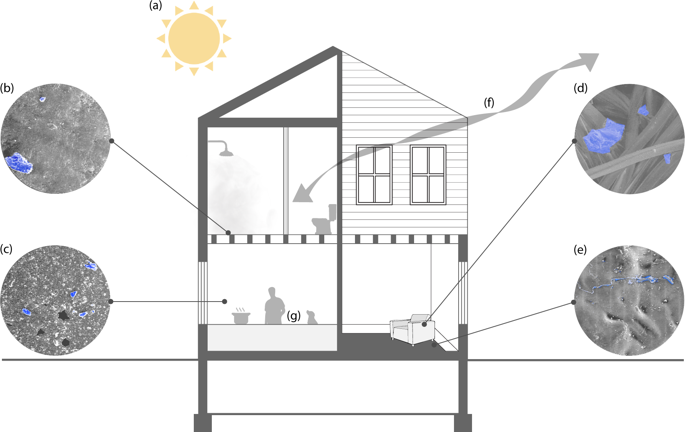当前位置:
X-MOL 学术
›
J. Expo. Sci. Environ. Epid.
›
论文详情
Our official English website, www.x-mol.net, welcomes your
feedback! (Note: you will need to create a separate account there.)
Building upon current knowledge and techniques of indoor microbiology to construct the next era of theory into microorganisms, health, and the built environment.
Journal of Exposure Science and Environmental Epidemiology ( IF 4.1 ) Pub Date : 2019-07-15 , DOI: 10.1038/s41370-019-0157-y Patrick F Horve 1 , Savanna Lloyd 1 , Gwynne A Mhuireach 1 , Leslie Dietz 1 , Mark Fretz 2 , Georgia MacCrone 1 , Kevin Van Den Wymelenberg 1, 2 , Suzanne L Ishaq 1
Journal of Exposure Science and Environmental Epidemiology ( IF 4.1 ) Pub Date : 2019-07-15 , DOI: 10.1038/s41370-019-0157-y Patrick F Horve 1 , Savanna Lloyd 1 , Gwynne A Mhuireach 1 , Leslie Dietz 1 , Mark Fretz 2 , Georgia MacCrone 1 , Kevin Van Den Wymelenberg 1, 2 , Suzanne L Ishaq 1
Affiliation

|
In the constructed habitat in which we spend up to 90% of our time, architectural design influences occupants' behavioral patterns, interactions with objects, surfaces, rituals, the outside environment, and each other. Within this built environment, human behavior and building design contribute to the accrual and dispersal of microorganisms; it is a collection of fomites that transfer microorganisms; reservoirs that collect biomass; structures that induce human or air movement patterns; and space types that encourage proximity or isolation between humans whose personal microbial clouds disperse cells into buildings. There have been recent calls to incorporate building microbiology into occupant health and exposure research and standards, yet the built environment is largely viewed as a repository for microorganisms which are to be eliminated, instead of a habitat which is inexorably linked to the microbial influences of building inhabitants. Health sectors have re-evaluated the role of microorganisms in health, incorporating microorganisms into prevention and treatment protocols, yet no paradigm shift has occurred with respect to microbiology of the built environment, despite calls to do so. Technological and logistical constraints often preclude our ability to link health outcomes to indoor microbiology, yet sufficient study exists to inform the theory and implementation of the next era of research and intervention in the built environment. This review presents built environment characteristics in relation to human health and disease, explores some of the current experimental strategies and interventions which explore health in the built environment, and discusses an emerging model for fostering indoor microbiology rather than fearing it.
中文翻译:

以室内微生物学的现有知识和技术为基础,构建微生物、健康和建筑环境的下一个时代的理论。
在我们花费 90% 时间的人工栖息地中,建筑设计影响着居住者的行为模式、与物体、表面、仪式、外部环境以及彼此之间的相互作用。在这种建筑环境中,人类行为和建筑设计有助于微生物的积累和扩散;它是传播微生物的污染物的集合;收集生物质的水库;引起人类或空气运动模式的结构;以及鼓励人类之间接近或隔离的空间类型,这些人的个人微生物云将细胞分散到建筑物中。最近有人呼吁将建筑微生物学纳入居住者健康和暴露研究和标准,但建筑环境在很大程度上被视为需要消除的微生物的储存库,而不是与建筑微生物影响密切相关的栖息地居民。卫生部门重新评估了微生物在健康中的作用,将微生物纳入预防和治疗方案,但尽管有人呼吁这样做,但建筑环境微生物学方面尚未发生范式转变。技术和后勤方面的限制常常妨碍我们将健康结果与室内微生物学联系起来,但已有足够的研究为下一个建筑环境研究和干预时代的理论和实施提供信息。这篇综述介绍了与人类健康和疾病相关的建筑环境特征,探讨了当前探索建筑环境健康的一些实验策略和干预措施,并讨论了一种促进室内微生物学而不是恐惧它的新兴模型。
更新日期:2019-11-18
中文翻译:

以室内微生物学的现有知识和技术为基础,构建微生物、健康和建筑环境的下一个时代的理论。
在我们花费 90% 时间的人工栖息地中,建筑设计影响着居住者的行为模式、与物体、表面、仪式、外部环境以及彼此之间的相互作用。在这种建筑环境中,人类行为和建筑设计有助于微生物的积累和扩散;它是传播微生物的污染物的集合;收集生物质的水库;引起人类或空气运动模式的结构;以及鼓励人类之间接近或隔离的空间类型,这些人的个人微生物云将细胞分散到建筑物中。最近有人呼吁将建筑微生物学纳入居住者健康和暴露研究和标准,但建筑环境在很大程度上被视为需要消除的微生物的储存库,而不是与建筑微生物影响密切相关的栖息地居民。卫生部门重新评估了微生物在健康中的作用,将微生物纳入预防和治疗方案,但尽管有人呼吁这样做,但建筑环境微生物学方面尚未发生范式转变。技术和后勤方面的限制常常妨碍我们将健康结果与室内微生物学联系起来,但已有足够的研究为下一个建筑环境研究和干预时代的理论和实施提供信息。这篇综述介绍了与人类健康和疾病相关的建筑环境特征,探讨了当前探索建筑环境健康的一些实验策略和干预措施,并讨论了一种促进室内微生物学而不是恐惧它的新兴模型。











































 京公网安备 11010802027423号
京公网安备 11010802027423号